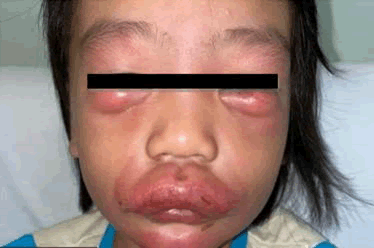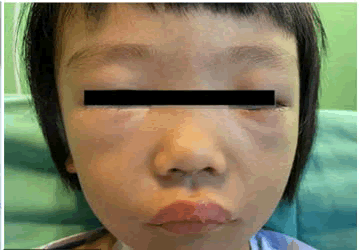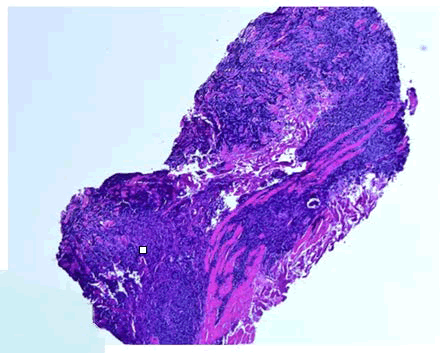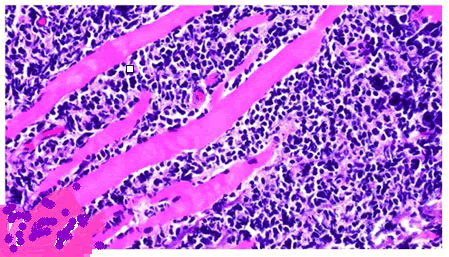Case Report - (2022) Volume 8, Issue 6
Acute Lymphoblastic Leukemia Presenting as Angioedema like Cutaneous Lesion in a Child
Hoi Ling Wong1*,
Jasminder Kaur Amarjit Singh1,
Sheng Chai Tan1 and
Nurul Shuhada Abd Hamid2
1Department of Paediatric, Sabah Women and Children’s Hospital, Sabah, Malaysia
2Department of Pathology, Hospital Queen Elizabeth, Kota Kinabalu, Malaysia
*Correspondence:
Hoi Ling Wong, Department of Paediatric, Sabah Women and Children’s Hospital, Sabah,
Malaysia,
Email:
Received: 08-May-2022, Manuscript No. IPCPDR-22-13311;
Editor assigned: 11-May-2022, Pre QC No. IPCPDR-22-13311(PQ);
Reviewed: 25-May-2022, QC No. IPCPDR-22-13311;
Revised: 10-Oct-2022, Manuscript No. IPCPDR-22-13311(R);
Published:
17-Oct-2022, DOI: 10.36648/2472-0143.8.6.29
Abstract
Leukemia Cutis (LC) is a term used to describe the infiltration of leukemic cells into the dermis or sub cutis tissue, resulting in different forms of skin manifestations. Aleukemia leukemia cutis refers to the presence of LC prior to the development of systemic leukemia. Leukemia cutis is more commonly associated with Acute Myeloid Leukemia (AML) compared to Acute Lymphoblastic Leukemia (ALL), although the latter accounts for the majority of acute leukemia cases in childhood. We report a child who presented with a rare and unusual cutaneous pattern of angioedema like lesion caused by leukemia cutis.
Keywords
Leukemia Cutis (LC); Acute Myeloid Leukemia (AML); Acute Lymphoblastic Leukemia (ALL);
Pancytopenia
INTRODUCTION
Leukemia is the commonest childhood malignancy which
accounts for 30% of all cancers diagnosed in the pediatric
population. Although ALL makes up for the majority of cases
of acute leukemia in childhood, AML is more frequently
associated with LC. In children, the onset of LC usually
happens concomitantly or after systemic disease has been
diagnosed. At times, LC may precede the development of
leukemic cells in the peripheral blood or bone marrow. This
condition is known as aleukemic lukemia cutis [1-7]. the
occurrence of leukemia cutis is not only confined to children
with high risk leukemia but also occurs in children with
standard and low risk leukemia. LC appears to occur more
commonly in children as compared to adults with AML [8].
We report a case of aleukemic leukemia cutis with an unusual
presentation of angioedema like features in a child.
Case Presentation
This is a previously well 5 years old girl who presented to the
emergency department with a history of fever and epistaxis
for 2 days duration. Upon examination, she appeared to be
mildly pale with hepatomegaly. There was no
lymphadenopathy. Full Blood Count (FBC) showed
pancytopenia with Hemoglobin (Hb) 9.8 g/dL, total White
Count (TWC) 1.9 x 109 /L (absolute neutrophil count of 0.06)
and platelet count 22 x 109/L. Peripheral Blood Film (PBF)
showed anemia with leucoerythroblastic picture and
increased schistocytes. No blasts or abnormal lymphoid cells
were seen. During her hospital stay she became hypotensive
and was admitted to the Paediatric Intensive Care Unit (PICU)
for neutropenia septic shock, requiring intravenous antibiotics
and inotropic support. Blood culture done revealed no growth
of organism. Ultrasound abdomen did not show any intra abdominal collection. Bone Marrow Aspiration and Trephine
biopsy (BMAT) reported edematous marrow with an excess of
blasts cells which are likely to be haematogones. BMA
Immunophenotyping showed the presence of 4.69-6.98% of
CD10+ B-lymphoblast. No cytogenetic abnormalities were
detected. BMA culture did not grow any organism. Cerebral
Spinal Fluid (CSF) examination was clear from blasts or
abnormal lymphoid cells. She was discharged home after 3
weeks of hospital stay when her fever subsided, and her
clinical condition improved. Serial blood count monitoring
revealed persistent bicytopenia (lymphopenia with anaemia).
Approximately 7 weeks from her initial presentation, she
started to develop progressive bilateral and symmetrical
erythematous swellings over both lower eyelids. This was
followed by perioral and lip oedema, resembling a child with
angioedema (Figures 1 and 2). There was no involvement of
the oral mucosal. There was no associated wheezing,
shortness of breath, skin pruritus or pain. There was no family
history of angioedema. At the same time, she was found to
have developed generalized lymphadenopathy with
hepatosplenomegaly. Repeated FBC showed bicytopenia with
mild anaemia (Hb 10 g/dL) and leucopenia (TWC 3.3 x 109/L,
ANC 1.48). Her platelet counts were normal (PLT 205 x 109/L).
Repeated PBF did not reveal evidence of blast cells. MRI brain
and orbit was done showing bilateral eyelid thickening with
normal brain structure. A decision was made to perform a
skin biopsy at the left lower eyelid as well as a cervical lymph
node biopsy. The histopathological findings from the biopsy
showed infiltration of malignant cells (Figures 3 and 4).
Approximately 4 weeks after her biopsy, repeated BMAT
showed the presence of excessive blasts cells of 85% in the
bone marrow, which were morphologically consistent with
leukemic cells, confirming a diagnosis of B cell ALL. She was
started on chemotherapy following the all AEIOP BFM 2009
(International collaborative treatment protocol for children
and adolescents with acute lymphoblastic leukemia). The per
orbital and perioral swelling improved significantly within 5
days of starting chemotherapy [9,10].

Figure 1: Clinical picture of patient showing bilateral
symmetrical firm swellings involving the lower eye lids and
the lips as well as the chin, mimicking angioedema.

Figure 2: Marked improvement and reduction of perioral and
periorbital swelling after 5 days of chemotherapy.

Figure 3: Lower eyelid biopsy: Neoplastic cells diffusely
infiltrating the fibro collagenous tissue and muscle fibers of
the lower eyelid. H and E staining.

Figure 4: Higher magnification shows lymphoblasts
in between the muscle fibers. these cells have round to oval
to convoluted nuclei, inconspicuous nucleoli and
scant cytoplasm. H and E staining.
Results and Discussion
Leukemia cutis has been reported to present with a variety of
manifestations which includes macules, papules, patches,
infiltrated plaques, nodules, petechiae or purpura. These
lesions have a propensity to develop over the head, neck and
scalp areas. In newborns, the term “blueberry muffin” is often
used to describe LC which presents as multiple erythematous
to lilaceous skin nodules. Current published data in the
literature reveals that about one third of cases of leukemia
presents simultaneously with LC. It was found that less than
10% of cases of leukemia start with an initial skin presentation
of aleukemic leukemia cutis. Although acquired angioedema
has been reported to be associated with lymphoproliferative
diseases in adulthood, to our best knowledge, LC mimicking
angioedema in children has not been reported in the
literature to date. In the case study reported above, the child
was found to have pancytopenia during her initial
presentation. However, the first PBF and BMAT done did not
reveal the presence of blasts cells. Repeated serial PBF
remained clear from malignant cells despite the development
of angioedema like features. Skin biopsy over the eyelid and
lymph node biopsy from the cervical region finally clinched
the diagnosis of malignancy, showing malignant lymphoid
tissues with mitotic. Differential diagnoses of hereditary
angioedema and acquired angioedema were considered in
this case. Given the lack of a positive family history of
angioedema, it was thought that acquired angioedema due to
C1 inhibitor (AAE-C1-INH) deficiency was more likely to be the
diagnosis. We were unable to exclude the diagnosis C1
inhibitor deficiency in this patient as the laboratory testing
was not available in our clinical setting. However, the
progressive swelling of her eyelids and lips over a period of 2
weeks did not fit into the typical scenario seen in AAE-C1-INH,
of which, symptoms typically resolve within 2-5 days. Skin
biopsy eventually allowed for a diagnosis of malignancy in our
patient. To date, there is no consensus of the association
between the presence of LC and the prognosis of leukemia in
childhood. Some authors have considered LC to be an
indicator of poorer prognosis or even an indicator of higher
chance of relapse of disease. Our patient was classified as
having standard risk leukemia and was started on
chemotherapy accordingly. Her facial swelling resolved with
no residual dyspigmentation or scarring after commencement
of treatment. More studies are required to determine
whether aleukemic cutis is associated with poorer prognosis
in childhood leukemia.
Conclusion
Acute leukemia in children is known to be associated with a
variety of cutaneous findings. To the best of our knowledge, LC presenting as angioedema like facial lesions has not been
reported in children previously. Our case not only adds to the
new skin presentation of acute leukemia but also illustrates
the importance of performing skin biopsy for any atypical skin
presentation associated with abnormal blood counts because
LC can precede the diagnosis of acute leukemia in childhood.
References
- Dewan P, Gomber S, Banerjee A, Grover C, Kotru M (2018) Leukemia cutis an unusual presentation in a child of acute lymphoblastic leukemia. J Pediatr Hematol Oncol. 3(3):22–23.
[Crossref]
- Arora RS, Arora B (2016) Acute leukemia in children: A review of the current Indian data. South South Asian J Cancer. 05(03):155-160.
[Crossref][Google Scholar][Indexed]
- Bay A, Oner AF, Tuncer O, Atas B, Yuca S, et al. (2004) Acute Lymphoblastic Leukemia Presenting as Cutaneous Involvement. Eur J Gen Med. 1(2):46-47.
[Crossref][Google Scholar][Indexed]
- Belson M, Kingsley B, Holmes A (2007) Risk factors for acute leukemia in children: A review. Environ Health Perspect. 115(1):138-145.
[Crossref][Google Scholar][Indexed]
- Godínez-Chaparro JA, Valencia-Herrera AM, Duarte-Abdala MR, Mena-Cedillos CA, Toledo-Bahena ME (2021) Leukemia cutis and other dermatological findings in pediatric patients with acute myeloid leukemia. Bol Med Hosp Infant Mex. 78(5):411-417.
[Crossref][Google Scholar][Indexed]
- Millot F, Robert A, Bertrand Y, Mechinaud F, Laureys G, et al. (1997) Cutaneous involvement in children with acute lymphoblastic leukemia or lymphoblastic lymphoma. Pediatrics. 100(1):60–64.
[Crossref][Google Scholar][Indexed]
- Andriescu EC, Coughlin CC, Cheng CE, Prajapati VH, Huang JT, et al. (2019) Pediatric leukemia cutis: A case series. Pediatr Dermatol. 36(5):658-663.
[Crossref][Google Scholar][Indexed]
- Cho-Vega JH, Medeiros LJ, Prieto VG, Vega F (2008) Leukemia cutis. Am J Clin Pathol. 129(1):130-142.
[Crossref][Google Scholar][Indexed]
- Wonnaparhown A, Stefanovic A, Lugar P, Hostetler HP (2021) Acquired angioedema in B cell lymphoproliferative disease: A retrospective case series. Clin Exp Immunol. 206(3):378-383.
[Crossref][Google Scholar][Indexed]
- Otani IM, Banerji A (2017) Acquired C1 Inhibitor Deficiency. Immunol Allergy Clin North Am. 37(3):497-511.
[Crossref][Google Scholar][Indexed]
Citation: Wong HL, Singh JKA, Tan SC, Hamid NSA (2022) Acute Lymphoblastic Leukemia Presenting as Angioedema like
Cutaneous lesion in a Child. Clin Pediatr Dermatol. 8:29
Copyright: © 2022 Wong HL, et al. This is an open-access article distributed under the terms of the Creative Commons
Attribution License, which permits unrestricted use, distribution, and reproduction in any medium, provided the original author
and source are credited.





